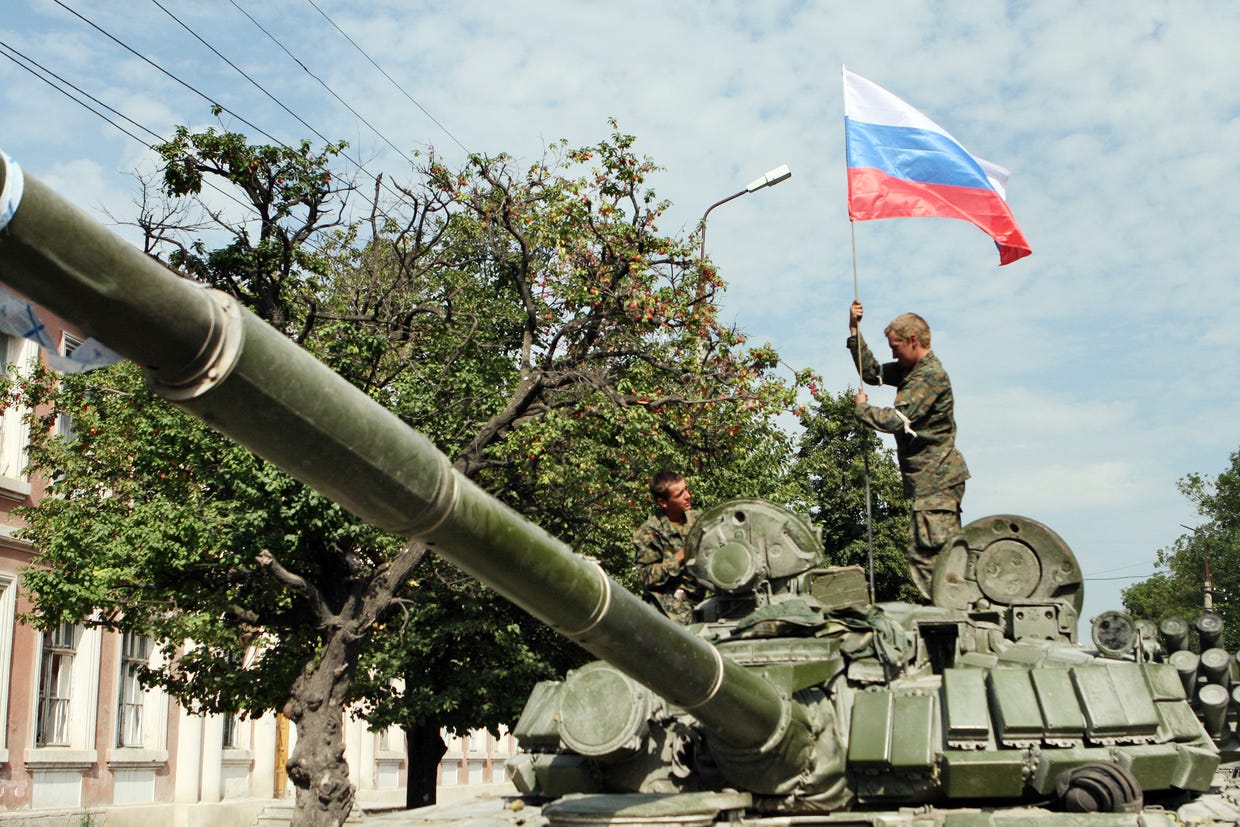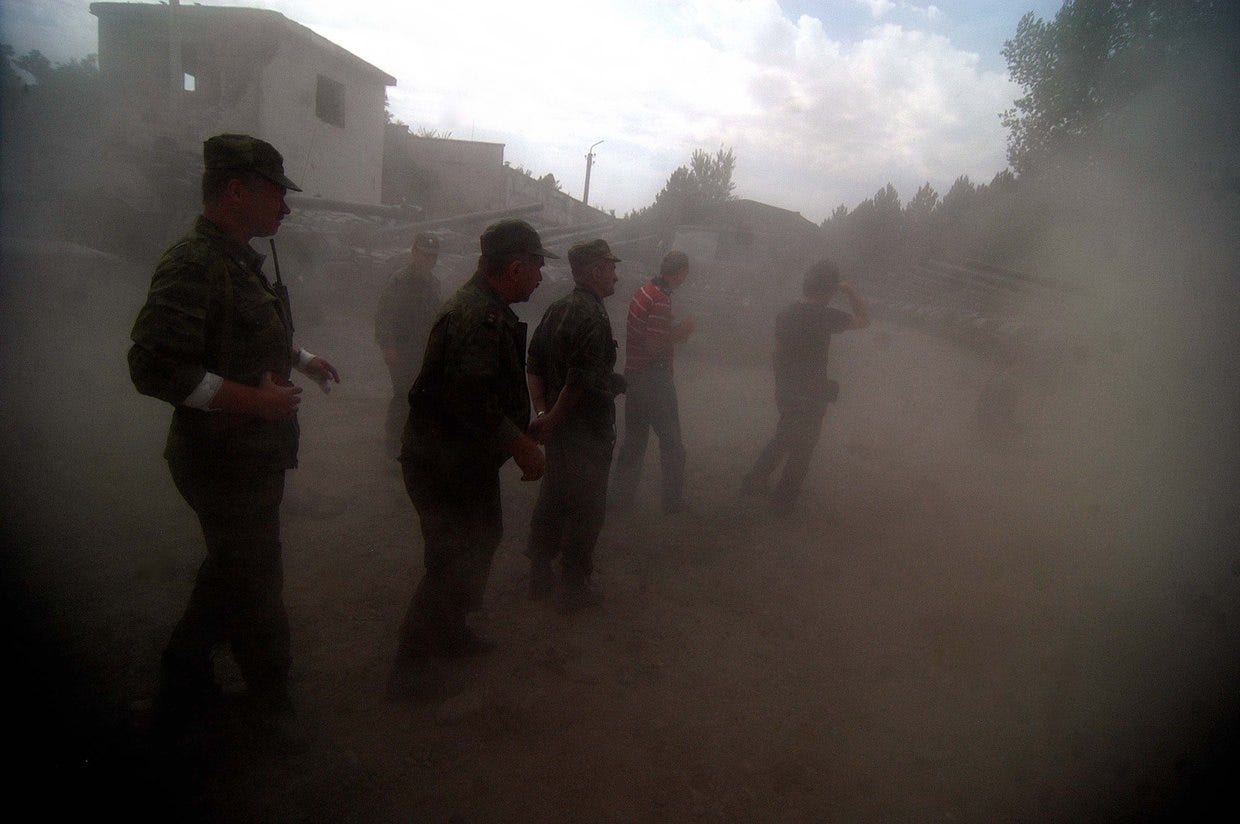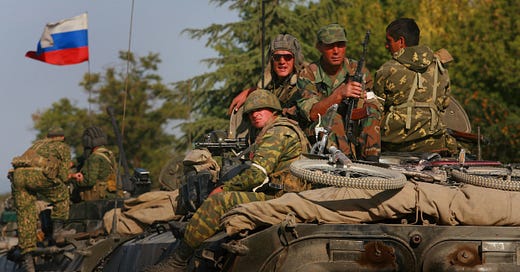How the ambitions of a small country's US-backed leader launched the current confrontation between Russia and the West
In 2008, the Russian army carried out its first major foreign operation of the 21st century. Here's how it happened.
Combat units of the Russian army, using old Soviet tanks that kept breaking down, made their way across mountain ranges. Their mission was to rescue a small group of peacekeepers encircled by the enemy and put an end to the shelling of a small town nestled deep in the Caucasus Mountains.

The Russian troops didn’t carry any advanced weapons; they even lacked adequate military communications – and yet, thanks to high morale, they made the enemy surrender in just five days. This, in broad strokes, is the 2008 war in South Ossetia – one of the many territorial conflicts sparked by the collapse of the Soviet Union.
To Moscow, this conflict was of special significance: not only did it mark the beginning of Russia's current confrontation with the West, but it also prompted a sweeping modernization of the Russian army.
Origins of the conflict in South Ossetia
The Soviet Union collapsed over 30 years ago, exposing multiple simmering conflicts that had previously been kept dormant by the repressive apparatus of the state. With the dissolution of the USSR, many of these deep-rooted conflicts resurfaced, followed by numerous fresh disputes. Only a handful of them have been successfully resolved in the past 30 years. The vast majority remain ‘in stasis,’ liable to erupt at any moment, with unpredictable consequences.
At the center of one of these conflicts were the Ossetians, a people living on both sides of the Greater Caucasus mountain range. They make up the majority of the population in Russia’s Republic of North Ossetia. There is, however, another sizeable community in South Ossetia, a densely populated territory separated from its northern counterpart. In the 19th century, the territories of the North Caucasus, including those of the future Georgian state, were incorporated into the Russian Empire. At that time, collective Georgian statehood was in its infancy, and the Russian empire, like any other empire, would not tolerate even bringing up the idea of separatism.
It all changed after the Russian Civil War. As part of the newly formed Soviet Union, Georgia existed as a patchwork of the core plus three autonomous regions (Abkhazia, Adjara and South Ossetia) and multiple other areas (not given their own separate status) populated by Armenians and Azerbaijanis. The South Ossetian autonomous region was a backwater province, quiet and undisturbed, with Georgians and the Ossetians living alongside each other. This region was and still is a small one with an area of 50x50 km and a population of less than 50,000, most of whom live in the region's only city, Tskhinval.
Unfortunately for Georgia, when the Soviet Union collapsed, a man named Zviad Gamsakhurdia became its first president. He was utterly obsessed with nationalist ideas. At the same time, a movement for national autonomy gained momentum in Ossetia. Gamsakhurdia branded the Ossetians “trash” and attempted to launch a punitive expedition into the region. His plans failed, however, as neither the Georgian nationalists nor the local militia had any experience of real combat. In the early 90's, a short-lived and pointless but bloody war ended in negotiations. South Ossetia declared itself a republic; Georgia refused to recognize it, but the conflict was put on ice, and a Russian peacekeeping battalion was deployed in the region at the consent of both sides.
The following 15 years were uneventful – South Ossetia is, after all, a small region hidden deep in the mountains. It maintained contact with its sister republic of North Ossetia through the only road that led north via the Roki tunnel. The republic had no natural resources of major significance, and the great powers of the world had no interest in it whatsoever.
Georgia’s Reconquista
But then, in the early 2000s, a young and ambitious Mikhail Saakashvili became Georgia’s third president, launching massive reforms and changing the country’s outlook to pro-Western and, most of all, pro-American. While Saakashvili managed to jump-start the economy to a degree, to the point that Georgia briefly became the poster child for a successful westernization, he had other interests, too, and they included restoring Georgia’s territorial integrity. The dissolution of the Soviet Union, followed by a number of local civil conflicts, had left the former Georgian SSR lacking a few territories. South Ossetia and Abkhazia had proclaimed their independence, and on top of that Tbilisi lost control of Adjara, an area of importance in the country’s southwestern corner, as well as the Pankisi Gorge and the Kodori Valley.
Saakashvili began building a reformed army to achieve the goal of bringing back the provinces that had gone rogue. Georgian troops were trained by the US and its NATO partners. The president stuck to his westernization policy with regards to the army too. Georgia increased its military spending to 9.5% of GDP, which is extremely high – more typical for a nation in a state of war.
What’s interesting is that the US didn’t see any of that as important or necessary, although it was happy to take Georgia under its wing. It was rather Saakashvili’s personal project. He obviously wanted to enter history as the man who restored Georgia in every possible sense of the word. In his speeches, he liked to mention conquests and heroes of the past, going back to the Middle Ages. Besides, the problem of Georgian refugees was a real one: the violent armed conflicts that broke out in the 1990s had driven many from their homes, and they never got the chance to return.
Adjara didn’t put up any resistance and was reunited with Georgia peacefully. The Pankisi Gorge and the Kodori Valley followed suit. South Ossetia and Abkhazia, however, presented a challenge. Both were self-proclaimed republics that had announced their independence from Georgia and had armed forces of their own. Russia had been supportive of both republics ever since, providing military, political, and financial aid. The attempted negotiations between Georgia and the republics failed, since the violence committed by both sides in the 1990s was a major stumbling block.
That’s when Mikhail Saakashvili decided it was time for a military operation.
Swiss watch plan
Believe it or not, neither of the patron states of the involved parties wanted a war – neither Russia nor the United States. Thanks to documents leaked by the WikiLeaks project, we know that American diplomats considered Moscow’s concerns about a possible military move on the part of Saakashvili nothing but a case of paranoia. Some experts even believe that the United States simply never consolidated its official position in regard to Saakashvili’s ambitious plans, while the president might have misinterpreted the somewhat ambivalent signals coming from Washington as a sign of support and a green light for his project of a lifetime.
One big problem was that a Russian peacekeeping force was permanently deployed in South Ossetia and that Moscow had made it clear it wasn’t going to tolerate an attack.

It seemed impossible for Saakashvili to simply go ahead and challenge Moscow, but he had a sort of plan. Knowing that the only road connecting South Ossetia and Russia goes over the Main Caucasian Range, making it impossible to deliver any significant reinforcements fast, Saakashvili placed his bet on taking control of the Roki Tunnel, a key passage point on that road, thus cutting off the peacekeeper force and forcing it to capitulate. He was going to rely on this advantage.
South Ossetia couldn’t boast any significant military force. Whatever troops it had were commanded by an experienced Russian colonel, Anatoly Barankevich. Most of the fighters, however, didn’t have any military training or experience and lacked proper munitions, let alone artillery or armored vehicles. The republic relied heavily on Russia’s support.
Since earlier in the summer of 2008, the sides had occasionally exchanged fire on the border between South Ossetia and Georgia. Tskhinval (the Ossetian name for the country’s capital, Georgians used to call it Tskhinvali) is very close to the border – only a few hundred meters separate it from the nearest Georgian village. The republic began to evacuate women and children.
On the night of August 7, Tskhinval came under shell fire. Apparently, the Georgian reconnaissance units didn’t do a very good job, because the Ossetian militia fighters were hardly affected. Refugees began to flee Tskhinval. The Russians were blocked at their base and kept firing. They were able to destroy a Georgian tank, but that was the only tactical victory at that point. Over ten peacekeepers were killed, and the rest had to retreat to the basement.
Russian retribution
The Georgian plan began to malfunction on August 8. Two brigades tried to enter Tskhinval from different sides but came under fire and suffered significant losses. Colonel Brankevich, the militia commander, personally stopped one tank with a grenade launcher. Its crew is still considered missing in action – the ammunition exploded and practically turned the personnel into ash. Brankevich’s soldiers burned down a few more vehicles. At that time, the Russian military were quickly entering the republic from the north. It had become clear a few months before the events that Saakashvili was going to launch an attack, and South Ossetia had formed combat groups to prepare for it. The Georgians failed to take over Tskhinval on the first day, and now chaotic and violent street battles were raging.

Nervous breakdowns and incompetence kill people faster than a premeditated crime. The Georgian soldiers mostly just shot everywhere. A scene like something out of a comedy sketch occurred in one building. The Georgians destroyed the gate with their gunfire, stormed the house and stumbled on a stunned elderly couple. “What are you doing here?” the officer asked. “We live here,” was the obvious answer. The gob-smacked warriors had no other choice but to leave.
At the same time Russian jets began to bomb Georgian troops deployed to Tskhinval. The Georgians failed to get to the Roki Tunnel or destroy the Gufta bridge, which they tried to do in order to cut off enemy reinforcements. The road leading north was flooded with refugees, while Russian soldiers were moving in the opposite direction.
The Russian army was in bad shape in 2008. A significant number of vehicles were lost along the way – some of them were simply pushed off the cliffs, so that they wouldn’t block the road. Communication systems were awful, with officers often switching to their regular mobile phones. But morale was surprisingly high – the troops engaged in battles right away and were very effective. There was still a significant degree of chaos, however.
On the whole, the Russians were able to gain momentum during the first two days. Several battalions entered South Ossetia – they unblocked the peacekeepers, while the Georgian troops suffered significant losses. The Russian army didn’t show much in the beginning, but proved effective against Georgian artillery, and new battalions kept arriving through the tunnel. The Russians lost a few jets, but overpowered the Georgian Air Force and air defense, and destroyed several missile boats in the Black Sea. The jets bombed Georgian targets near and behind the frontline, but sometimes they made mistakes and hit civilians along with the combatants.

The Georgian army collapsed after August 10. In the 4th Brigade, for example, 2,000 staff were punished for desertion – several times more than the number of its killed and wounded. The Russians simply disarmed and let go a large Georgian force blocked in the west of the country. All of that while the Russian forces were still outnumbered.
On August 11, Saakashvili visited the frontline near the town of Gori. There he suddenly tried to run away, fearing an air raid, when he heard a sound of a jet. His bodyguards were there to bring him to the ground, but the media managed to take a photo of the Georgian leader with a face distorted by fear. Soon he added to that image by chewing his tie during a live broadcast.
Meanwhile, the West protested the “excessive use of force” by Russia, resulting in France’s Nicholas Sarkozy meeting then-president Dmitry Medvedev to negotiate a ceasefire. The hostilities stopped as rapidly as they had erupted. The Russian army pillaged Georgian military bases, taking home or destroying 65 tanks, 3,700 small arms and a plethora of other military equipment.
Big consequences of a small war
The war was over. The fighting took the lives of over 60 Russian and 180 Georgian soldiers, 37 Ossetian militia fighters, and more than 300 Ossetian and 200 Georgian civilians. For Ossetia, with a population of just 50,000, the blow was especially hard.
Russia soon recognized the independence of the Republics of Abkhazia and South Ossetia. Today, they are tiny and rather poor nations effectively under Russia’s protection.

The war in South Ossetia was a milestone for Moscow. It exposed the Russian army’s many problems and was enough to lay out a plan for improving the military. The victory over Georgia wasn’t thanks to the army’s combat effectiveness but rather thanks to the personal quality of its staff. The next few years saw Moscow conduct major reforms.
The politicians, however, had a slightly different perspective. For the first time since the fall of the Soviet Union, Russia had flexed its muscles in the global arena. Within the country, the common take on the events was as follows: the West had used its vassal state to test how Russia would react to a great infringement upon its interests. It was the first time Moscow had actively fought back against Western pressure, or what felt like pressure. The tensions only heightened over the ensuing years.
The key takeaway from the Five-Day War is that opportunism and recklessness can do more harm than scheming. The clueless pursuit of a single man’s ambition cost hundreds of lives. Those deaths could have been avoided had the politicians shown just a little more restraint and wisdom at the right time.
By Evgeny Norin, a Russian historian focused on conflicts and international politics
Original Article: How the ambitions of a small country's US-backed leader launched the current confrontation between Russia and the West
In 2008, the Russian army carried out its first major foreign operation of the 21st century. Here's how it happened.




